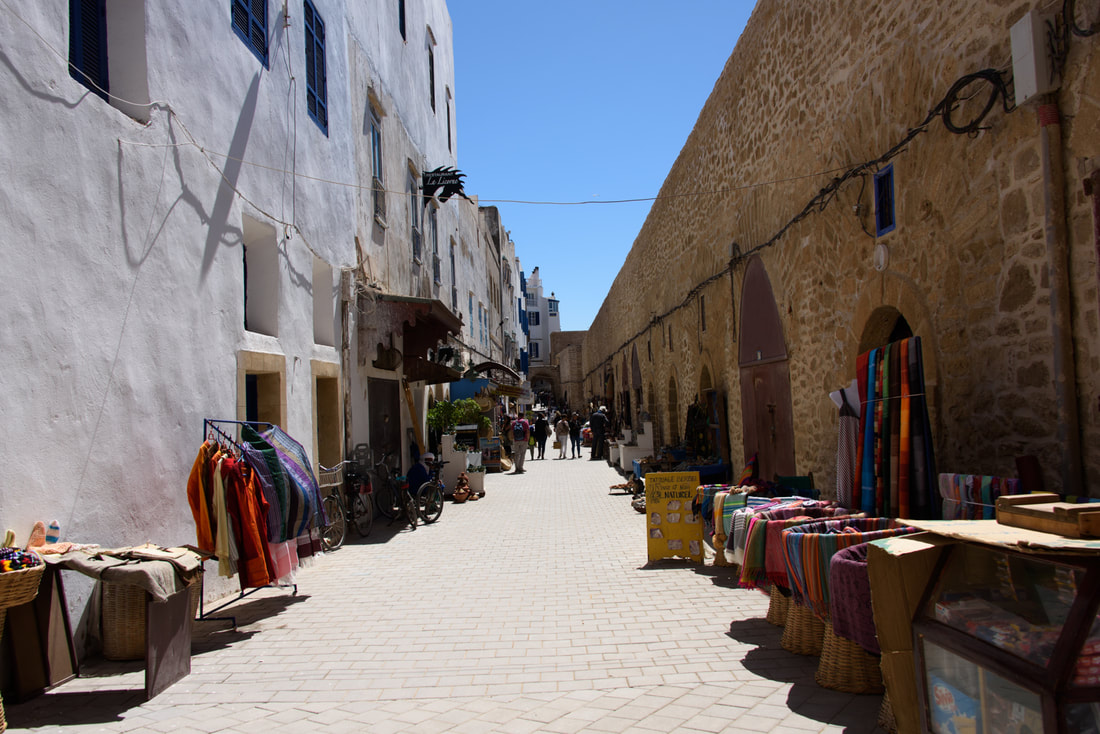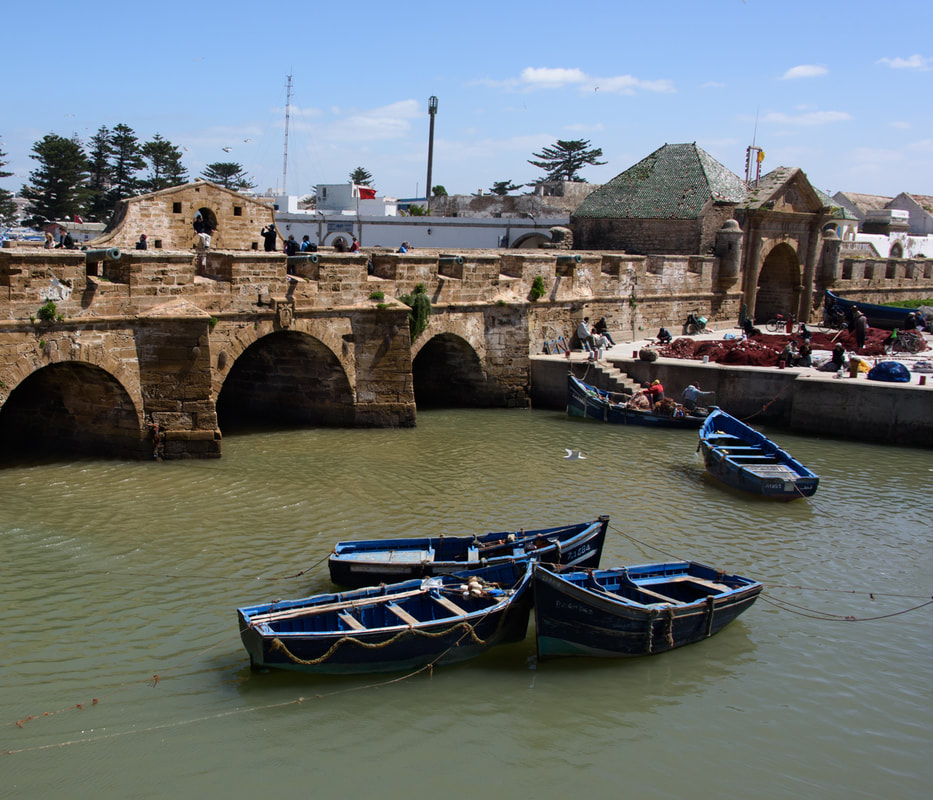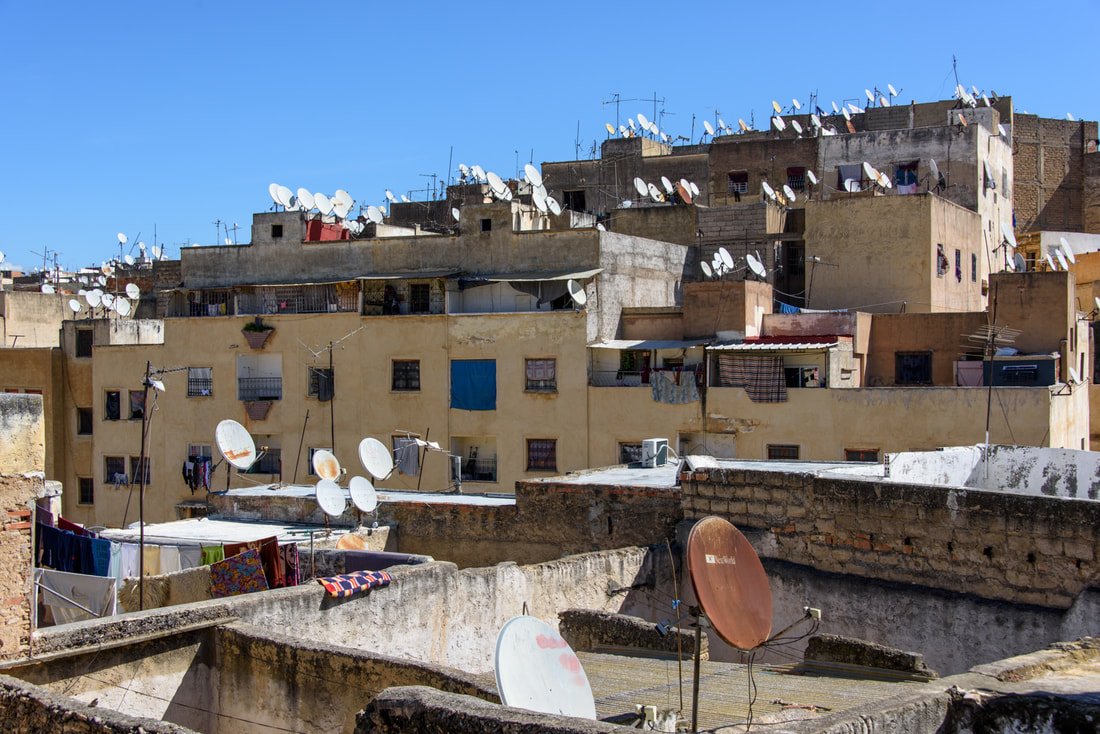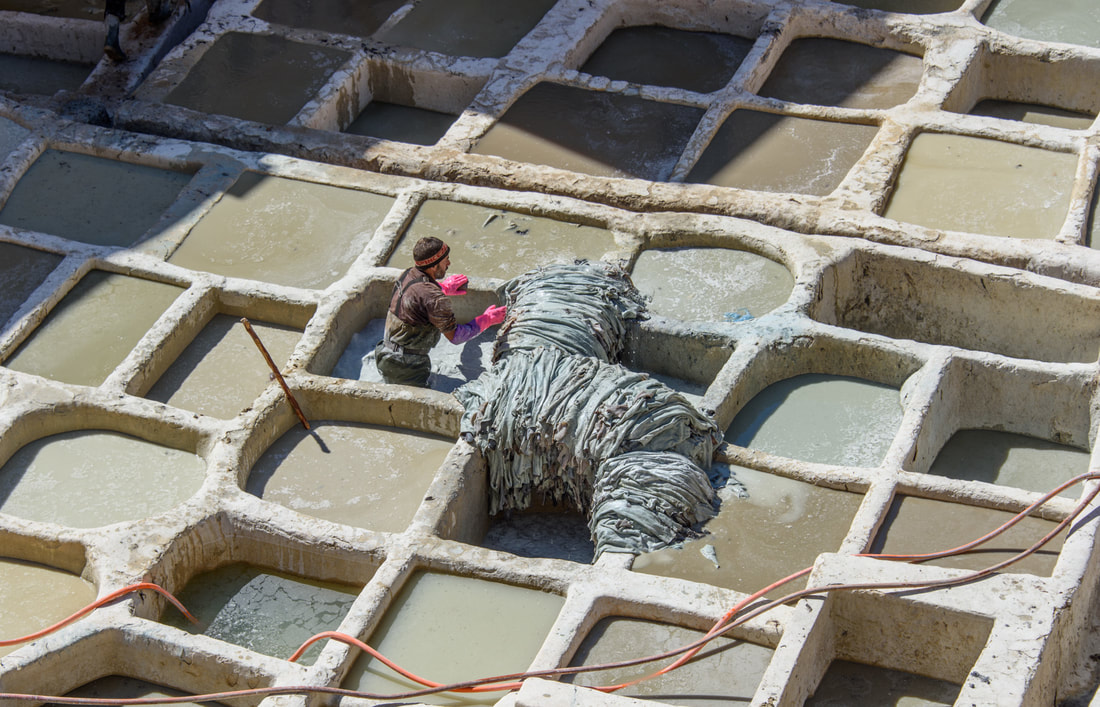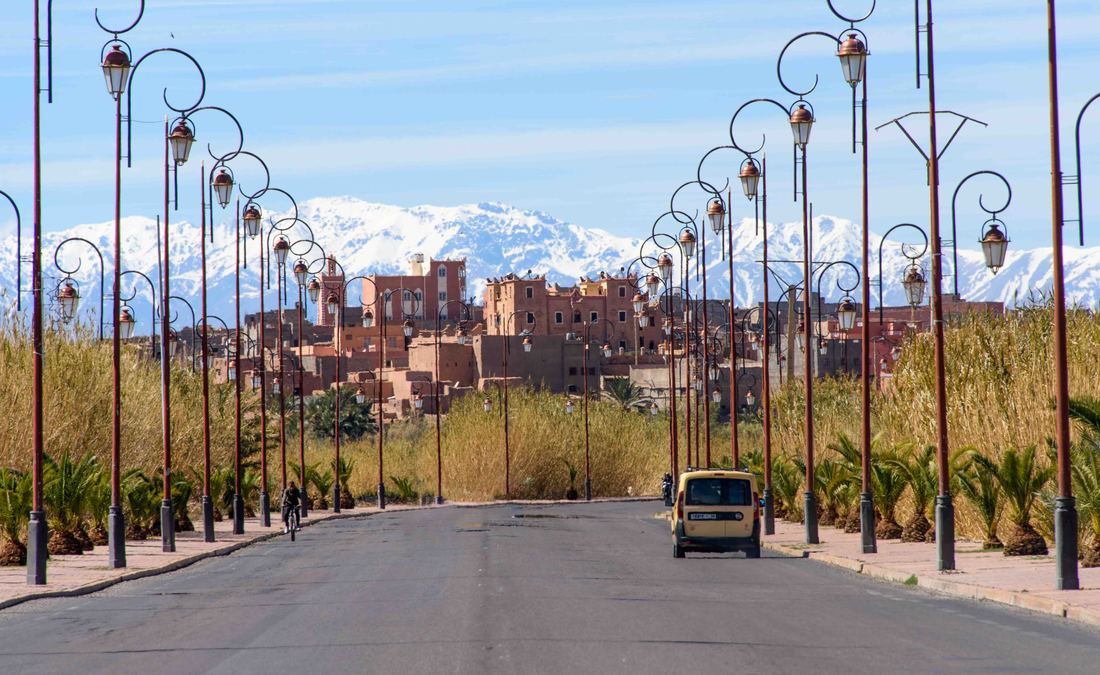
Sultan Moulay Ismaïl ruthlessly ruled (think unbridled torture and beheadings) here over 300 years ago. With a penchant for the fairer sex, he racked up 8 wives, a slew of lovers and over 800 children! But he put Meknes on the map, created his Imperial City and left behind lavishness we hadn’t seen elsewhere.
Above: the royal stables-designed to feed, water and shelter the 12,000 royal horses. (Meknes, Apr 12)

Called the blue city, Chefchaouen’s medina was a photographers dream (hence the indulgent number of pics).
Fun (?) facts: Up to 1920: Christians faced death if they attempted to enter the town. 1920-1956: The Spanish occupied the town and still today the language is commonly heard. 1930: The trademark pale blue wash was introduced. (Chefchaouen, Apr 9-10)

Jellabas are long traditional hooded robes with top to bottom front zippers. Although they are worn in Northern Africa, they are most often associated with Moroccan men from teenagers to the elderly. Depending on the material (wool or cotton) they can protect from the sun or a cold weather chill. After admiring its more ornate cousin - the djellaba - our desert camp host insisted we take his home.
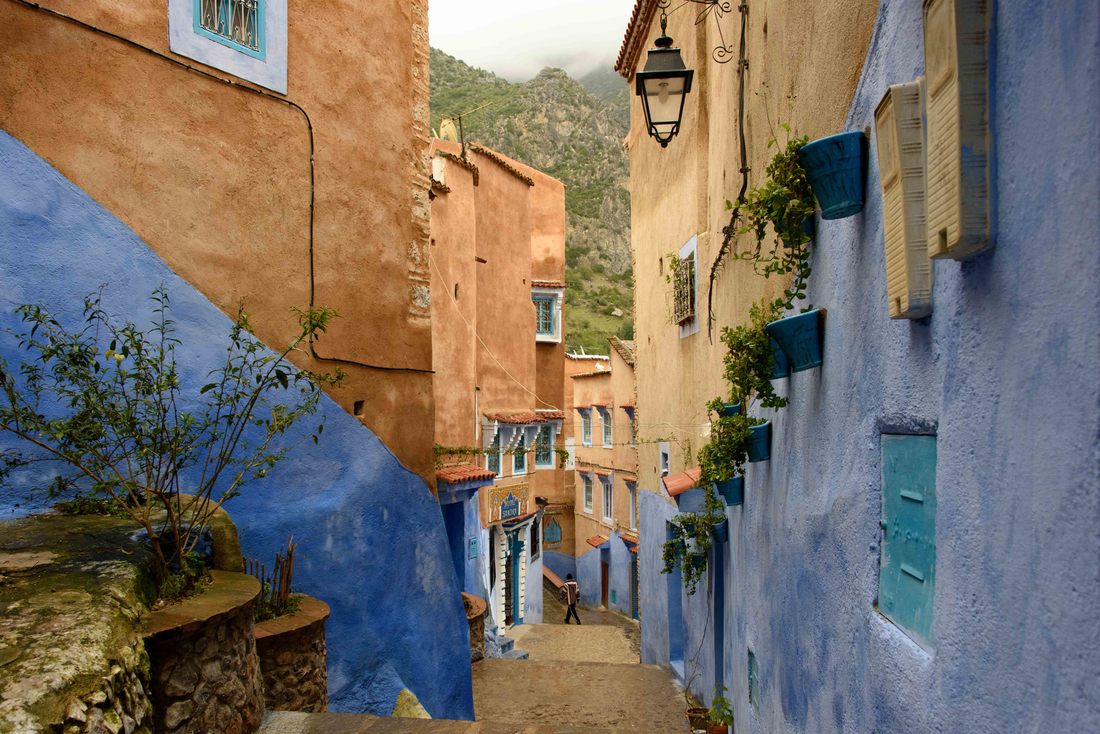
Marijuana plantations riddle the north and Chefchaouen is considered the center of it all. Technically the drug is illegal, but it’s moderately tolerated and Morocco is the largest supplier of hashish in the world. Rick has been offered it 5 times in the last 24 hours, yet there isn’t a single place to get a drink inside the medina. As an aside, does Rick really look like their demographic and why don’t I :)

Although settled in the 7th century BC, this site reached its height in AD42 by the Roman Empire. Used as a trading post for salt, olives and wine, there was also a brisk export business in wild African animals needed for the empire’s gruesome entertainment. Above, I’m sitting in one of the few amphitheaters the Romans built in Northern Africa. (Lixus, Apr 7)

With any one of us suffering from a different stage of food poisoning (?), the days in Marrakesh passed in a bit of a blur. Laying in bed and listening to the main square’s snake charmers play their flutes and the drummers keep a steady beat, there was something very Marrakeshian surreal about this exotic, despite its tourist heaviness, place. (Marrakesh, Apr 1-3)
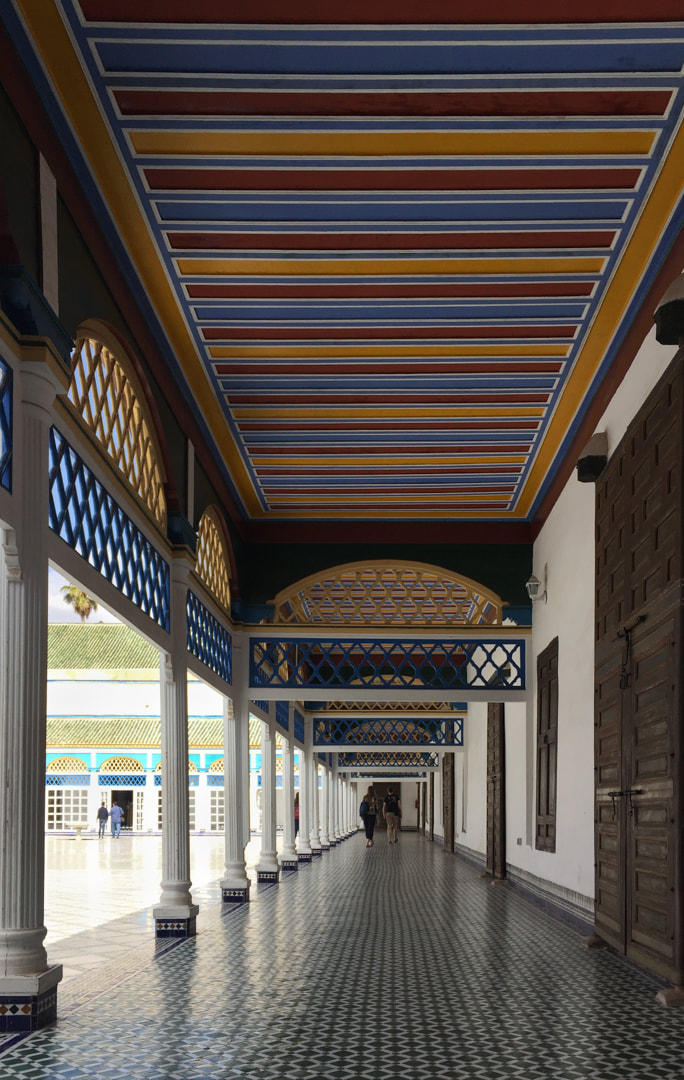
At nearly 5 acres, the Bahia Palace is one of the largest palaces in the medina. The flooring and much of the wall space of the main courtyard (above) and other rooms was painstakingly done in zellij - individually chiseled tiles set into geometrically patterned mosaics. Zellij is a hallmark of Moroccan décor, covering tables, ceilings, floors, fountains (below), etc.

European buyers have purchased and refurbished many of the guesthouses, from modest dars to sprawling and at times luxurious riads. This has pushed prices up, creating some resentment from the locals. The entrances often belie what hides behind. At times a guesthouse doesn’t even have a sign or number on the door-you simply have to remember its location.
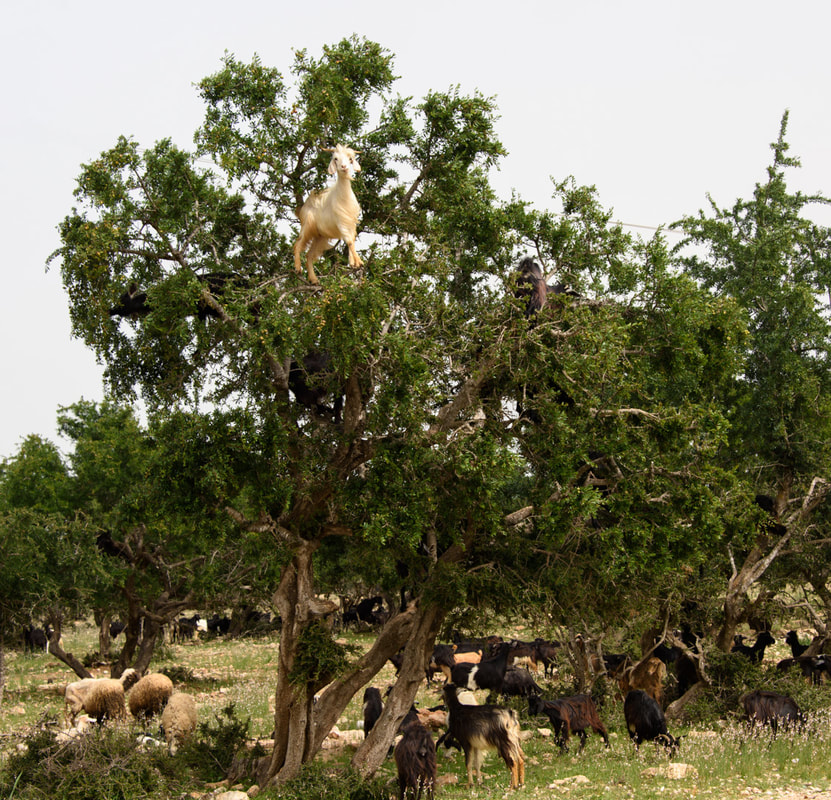
In a grove of argan trees these goats munched on the nuts. Although only the white goat was visible this and other trees were riddled with black ones. Sadly, a couple of days later we saw a tree full of too perfectly posed goats and upon closer inspection it was obvious that they had been tied to the branches. They attracted bus loads of tourists paying exorbitant fees to take a picture. (Essaouira, Mar 29)

The meat was added to a tajine container, each set over a tray of hot coals. Tajine is the staple of every menu and a tasty choice at that. Meat and/or vegetables are spiced and baked in a gravy in a pottery dish topped with a cone shaped lid. Those with some combination of almonds, apricots and prunes added are a favourite.

The walled medina in Fez is home to 70,000 people. The warren of streets, alleyways, dead ends and complete lack of any pattern make this place fascinating to explore, but difficult to find your way back to your start without either the help of one of the endless "guides" willing to help for a few dirham or a map app. (Fez, Mar 22-25)

In the simplest of terms, Morocco is divided into the north where there is a higher degree of education along with a push for development and modernization and the south where much of life continues as it has for centuries. Starting from Marrakesh we'll explore the latter for the next 3 weeks. (Mar 1-20)

The Sunday morning souq (market) drew hundreds of buyers and sellers from the region. Prices varied widely for the tourist-a package of green tea was quoted as 7 dirham at one kiosk and 150 at the next!! In this very local enterprise we saw less than a dozen other travelers so there was a slim opportunity for those outlandish profits :) (Taroudannt, Mar 18)

A hike in the hills passed through groves of argan trees. In addition to providing shade and animal feed, they prevent the land from turning to desert. The oil from the argan nut is becoming an in vogue replacement for olive oil and is hailed as a hair and skin wonder. In some regions, the nuts being eaten by goats and then ‘harvested’ from the droppings adds to their particular properties. (Tafaourt, Mar 16)

Fragrant almond blossoms blanketed the hills and valleys. Several trees hugged the road so closely that you had to give them a wide berth to avoid scratching the car. Although the almonds are harvested in late summer they can be eaten green and taste sweet, almost like a slightly crunchier apple. (Titeki, Mar 14)

Along a section of highway called the ‘route of the kasbahs’ sits the country’s pièce de résistance, the 17th century Kasbah Amridil. Three levels high with an opening from basement upwards to let in light, allow kitchen smoke to escape from the top floor, and to use as a chute to throw kitchen scraps down to the animals on the first floor. (Skoura, Mar 13)

A flour grinding stone... a handful of wheat poured into the top, a few rotations of the (very heavy) stone and some rough flour puffed out the bottom.

From a small shop came the sounds of a traditional Berber guitar. The musician is of some renown, having played in concerts around Europe, and makes the instruments himself. Suspending our concern over how to ship the odd shape home, we bought one. The post office proved to be a challenge, but nothing a roll of duct tape and mashed together boxes couldn't resolve. (Ait Ouglif, Mar 12)

Sharing the trail with donkeys and the Berber nomads making their daily decent for water from the river below. The women collect the water and do the laundry while the men take the sheep and goats out for the days grazing. They are fortunate because the river runs all year unlike so many dry beds elsewhere.

The country’s two main desert dunes are Erg Chebbi and Erg Chigaga. The former boasts the highest peaks, is easiest to access and the strongest draw for visitors. The latter are lower in height, stretch on for 40km, are difficult to access (4x4 driven by a skilled driver) and attract fewer visitors. As you can see we opted for the latter. Rick did his part here while the driver worked the other side. (El Gouera, Erg Chigaga, Mar 6-8)

Consequently for 2 nights we found ourselves the only guests in a ‘luxury’ desert camp designed for 10 others. Occasionally there was an ant sized sighting of other campers several dunes away. At times it felt awkward with the staff of eight fussing over us, yet at other times each of us found our own space of tranquility punctuated only by the chirping of the occasional visiting bird - it was pure nirvana.

At the end of a 3 hr ride that moved through terrain ranging from sand dunes to a parched and cracked moonscape sat a lone Berber ‘camp’. Aside from our transplanted lunch table, it couldn’t have been much more rudimentary. Still today some of the southern Berber people continue their nomadic lifestyle.

For as far as the eye could see, dromedaries took advantage of new vegetation to store fat in their hump for drawing on in leaner times. Some of the calves were only days old and barely able to stand. Berbers own herds of up to a hundred with the animals providing food, clothing and transport.
Fun fact: Australia has the only truly wild dromedaries.

Date palm groves fill this oasis located along the old trans-saharan trading route linking Marrakesh to Timbuktu. Beneath the trees each family has a small plot to grow their staples: almonds, dates, olives, apricots, plums, pomegranates, legumes, alfalfa, wheat and mint for the ubiquitous mint tea. (Mezguita, Mar 4)

Kasbahs, (fortified multi-family dwellings) were once owned by the wealthy for their extended kin. Today it’s not uncommon for them to act as apartments for the general population. This Kasbah Ciad dates back to the 16th century and is now being restored. Originally 250 families resided here, but today there are 24. (Tamnougalt, Mar 4)

As we wandered the periphery of this kasbah we ran into these 2 girls who were particularly chatty - my recall of grade 12 French was challenged. In the foreground lay 3 burial plots covered in cement. Wonder if they were for higher ranking individuals as other cemetery markers are simple upright, unmarked stones. (Tamnougalt, Mar 4)

This area is noted for birding and both of the town mosque’s minarets hosted stork nests. (Ouarzazate, Mar 2)

A tour showcased its gleaming enormity. The basement housed over 40 marble, lotus flower shaped ablution fountains for use before prayer.
A tour showcased its gleaming enormity. The basement housed over 40 marble, lotus flower shaped ablution fountains for use before prayer.














